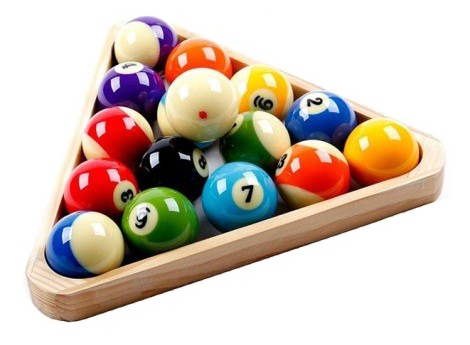There are numerous varieties of each game-particularly of carom and pocket billiards. Four-ball billiards or four-ball carom (often abbreviated to simply four-ball, and sometimes spelled 4-ball or fourball) is a carom billiards game, played on a pocketless table with four billiard balls, usually two red and two white, one of the latter with a spot to distinguish it (in some sets, one of the white balls is yellow instead of spotted). Otherwise (i.e., if the 8 ball is neither pocketed nor knocked off the table), the shooter’s turn is simply over, even if a foul occurs. Failure to do so is a foul if a referee is presiding over a match. If the final ball strikes one of the white skittles, this is a foul and if the ball should then enter the 100 or 200 holes, the game is forfeited. The white skittles are sometimes positioned either side of the 100 hole but more commonly, in this difficult variant, positioned in front of the 50 holes. If there is insufficient room on the long string between the foot spot and the foot rail cushion for balls that must be spotted, such balls are then placed on the extension of the long string “in front” of the foot spot (between the foot spot and the center spot), as near as possible to the foot spot and in the same numerical order as if they were spotted “behind” the foot spot (lowest numbered ball closest to the foot spot).
If a player under the same conditions intentionally causes the cue ball to contact an object ball behind the headstring, it is unsportsmanlike conduct. In-context commentary by pro player and pool writer Jerry Forsyth on rack 4: “What a beautiful layout for Immonen. He could not have asked for a better pattern to play. The first five balls are all down at the same end of the table; he doesn’t need to make the cue ball do a lot of work; this is a road map”. Tyler Eddy. In-context commentary by pool pro Danny DiLiberto. In-context commentary on rack 11 by pool pro Charlie Williams. Rob Saez. In-context commentary by pro player and pool writer Jerry Forsyth. A player can be awarded a point when the opponent commits a foul. 3. By standard, only two players can play the Snooker at a time. These are used for amateur and professional play. Play alternates in this manner for the remainder of the game. The object of ten ball billiards is to pocket the 10 ball legally to win the game. You can view the other version of Ten Ball snooker rules here.
Exception: if an object ball lies on or outside the head string (and is thus playable) but so close that the cue ball contacts it before the cue ball is out of the kitchen, the ball can be legally played. If with cue ball in hand behind the head string, the shooter causes the cue ball to accidentally hit an object ball, and the cue ball does not cross the headstring, the following applies: the incoming player has the option of calling a foul and having cue ball in hand, or having the balls returned to their original position, and having the offending player replay the shot. World Championship: What makes the perfect snooker player? Excerpts from professional snooker matches with detailed kick-related observations by professional commentators, with slow-motion replays. Winning hazard (or potting, in snooker terms) – striking another ball with one’s cue ball so that the red enters a pocket: 3 points; or striking another ball with one’s cue ball so that the other cue ball enters a pocket: 2 points. The red skittles forfeit just the current break score if toppled. Each red ball when pocketed remains in the pocket, while the colours when pocketed, as long as any reds remain on the table, are placed on their respective spots.
There are three ways to score points. 2 points for knocking a white ball off the table (this is a foul in tournaments). A legally pocketed ball entitles the shooter to continue at the table until he fails to pocket legally a called ball, or until he has pocketed all of the balls. The large rectangular table typically is twice as long as it is wide. In-context commentary on rack 10 by pool pro Dawn Hopkins. Ronato Alcano. In-context commentary by pool pros Danny DiLiberto and Jerry Forsyth. Byrne’s Treasury of Trick Shots in Pool and Billiards. Yes, see rule 8.1. The ball and the pocket must be designated, the other details are irrelevant, 10 ball billiards rules just as in Equal Offense or 14.1. Shots must be called in both the random and the rotation phases. Ray Reardon’s 50 Best Trick Shots. In-context commentary on rack 8 by pool pro Mike Sigel. Direct definition of “on the hill” for viewers and two in-context uses of “hill-hill” in commentary by pool pro Vicki Paski. In context commentary by pool pro Ewa Mataya Laurance. Mizerak, Steve; Mataya Laurance, Ewa; Forsyth, Jerry (2003). Quick-Start Guide to Pocket Billiards.
